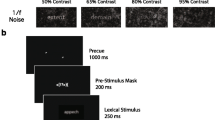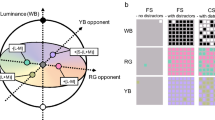Abstract
When older observers are defocused optically to the same reduced acuity levels as their younger adult counterparts they are better able to read distant text. This study sought to determine if this ability extended to intrinsically blurred (i.e., image-processed) stimuli of different types. Such an outcome suggests an explanation based on older persons’ greater experience with blurred stimuli; otherwise, one attributable to compensatory changes in the optic media of the older eye would be favored. Twelve young and 12 old healthy community-resident adult observers with excellent acuity were compared on their ability to identify low-pass filtered real words, nonsense words, scenes, and faces arranged in a sequence of decreasingly blurred images. Young observers were able to identify the images correctly earlier in the blur sequence than older adult observers, significantly so for both real and nonsense words. This finding suggests that compensatory changes in the eye’s optical media rather than older observers’ greater experience with blur accounts for their superior legibility performance with optically defocused text. While the image-enhancing effects of the age-related decline in pupil size (senile miosis) may be involved, further research is needed to clarify the mechanism(s) underlying this ability.
Similar content being viewed by others
References
Adams, A.J., Wong, L.S., Wong, L. & Gould, B. (1988). Visual acuity changes with age: Some new perspectives. American Journal of Optometry and Physiological Optics, 65, 403–406.
Barber, A.V. (1990). Visual mechanisms and predictors of far field visual task performance. Human Factors, 32, 217–233.
Burton, K. B., Owsley, C., & Sloane, M. E. (1993). Aging and neural spatial contrast sensitivity: Photopic vision. Vision Research, 33, 939–946
Calver, R.I., Cox, M.J., & Elliott, D.B. (1999). Effect of aging on the monochromatic aberrations of the human eye. Journal of the Optical Society of America A-Optics Image Science and Vision, (16): 2069–2078.
Campbell, F.W., & Green, D.G., (1965). Optical and retinal factors affecting visual resolution. Journal of Physiology, 181, 576–593.
Carroll, J.B., Davies, P., & Richman, B., (1971). Word Frequency Book. New York, NY: American Heritage Publishing.
Daugman, J.G., & Kammen, D.M., (1986). Pure orientation filtering: A scale invariant image-processing tool for perception research and data compression. Behavior Research Methods, Instruments, and Computers, 18, 559–564.
Elliot, D.B. (1987). Contrast sensitivity decline with aging: “A neural or optical phenomenon?” Investigative Ophthalmology & Vision Science, 21, 737–744.
Elliott, D., Whitaker, D., & MacVeigh, D. (1990). Neural contribution to spatiotemporal contrast sensitivity decline in healthy ageing eyes. Vision Research, 30, 541–547.
Elliott, D.B., Yang, K.C., & Whitaker, D. (1995). Visual acuity changes throughout adulthood in normal, healthy eyes: seeing beyond 6/6. Optometry and Vision Science, 72, 186–91.
Gittings, N. S., & Fozard, J. L. (1986). Age changes in visual acuity. Experimental Gerontology, 21, 423–434.
Gonzalez, R.C., & Wintz, P. (1977). Digital Image Processing. Reading, MA: Addison-Wesley.
Guiaro, A., Gonzale, G., Redondo, M., Geraghty, E., Norrby, S., & Artal, P. (1999). Average optical performance of the human eye as a function of age in a normal population. Investigative Ophthalmology & Visual Science, 40, 203–213.
Guirao, A., Redondo, M., & Artal, P. (2000). Optical aberrations of the human cornea as a function of age. Journal of the Optical Society of America, A, Optics, Image Science, & Vision, 17, 1697–1702.
Haegerstrom-Portnoy, G., Schneck, M.E., & Brabyn, J.A. (1999). Seeing into old age: Vision function beyond acuity. Optometry and Vision Science, 76, 141–158.
Kaplan, H.L., (1983). Session VII: An introduction to the theory and application of fast Fourier transforms. Behavioral Research Methods and Instrumentation, 15, 228–241.
Kline, D.W. (1991). Aging and the Visibility of Highway signs: A New Look through Old Eyes. Washington, D.C.: AAA Foundation for Traffic Safety.
Kline, D. (1994). Optimizing the visibility of displays for older operators. Experimental Aging Research, 20, 11–23.
Kline D. W., Buck, K., Sell Y. P., Bolan T., & Dewar R.E. (1999). Older observers’ tolerance of optical blur: age differences in the identification of defocused text signs. Human Factors, 41, 356–364.
Kline, D.W. & Fuchs, P. (1993). The visibility of symbolic highway signs can be increased among drivers of all ages. Human Factors, 35, 25–34.
Kline, D. W., Kline, T. J. B., Fozard, J. L., Kosnik, W., Schieber, F., & Sekuler, R. (1992). Vision, aging and driving: The problems of older drivers. Journal of Gerontology: Psychological Sciences, 47, 27–34.
Kline, D. W., Schieber, F., Abusamra, L. C., & Coyne, A. C. (1983). Age and visual channels: Contrast sensitivity and response speed. Journal of Gerontology, 38, 211–216.
Legge, G.E., Mullen, K.T., Woo, G.C., and Campbell, F.W. (1987). Tolerance to visual defocus. Journal of the Optical Society of America, 4, 851–863.
Leibowitz, H., Post, R., & Ginsburg, A., (1980). The role of fine detail in visually controlled behavior. Investigative Ophthalmology & Visual Science, 19, 846–848.
Levi, D.M., & Klein, S.A., (1990a). Equivalent intrinsic blur in amblyopia. Vision Research, 30, 1995–2022.
Levi, D.M., & Klein, S.A., (1990b). Equivalent intrinsic blur in spatial vision. Vision Research, 30, 1971–1993.
Loewenfeld, I.E. (1979). Pupillary changes related to age. In H.S. Thompson (Ed.), Topics in Neuro-Opthalomolgy (pp. 124–150). Baltimore: Williams and Wilkins.
Nio, Y.K., Jansonius, N.M., Fidler, V., Geraghty, E., Norrby, S., & Kooijman, A.C. (2000). Age-related changes of defocus-specific contrast sensitivity in healthy subjects. Ophthalmic & Physiological Optics, 20, 323–334.
Oshika, T., Klyce, S.D., Applegate, R.A. & Howland, H.C. (1999). Changes in corneal wavefront aberrations with aging. Investigative Ophthalmology & Visual Science, 40, 1351–1355.
Owsley, C., & Sloane, M.E. (1987). Contrast sensitivity, acuity, and the perception of ‘real world’ targets. British Journal of Ophthalmology, 71, 791–796.
Owsley, C., Sekuler, R., & Boldt, C. (1981). Aging and low-contrast vision: face perception. Investigative Ophthalmology & Visual Science, 21, 362–365.
Owsley, C., Sekuler, R., & Siemensen, D. (1983). Contrast sensitivity throughout adulthood. Vision Research, 23, 689–699.
Pitts, D. G. (1982). The effects of aging on selected visual functions: Dark adaptation, visual acuity, stereopsis, and brightness contrast. In Sekuler, R., Kline, D.W. and Dismukes, K., (Eds.), Aging and Human Vision Function. (pp. 139–159) NY: Alan R Liss.
Royer, F.L., Rzeszotarski, M.S., & Gilmore, G.C., (1983). Application of two dimensional Fourier transforms to problems of visual perception. Behavioral Research Methods and Instrumentation, 15, 319–326.
Rubin, G.S., Roche, K.B., Prasada-Rao, P., & Fried, L.P. (1994). Visual impairment and disability in older adults. Optometry and Vision Science, 71, 750–760.
Rubin, G.S., & Siegel, K. (1984). Recognition of low-pass filtered faces and letters. Investigative Ophthalmology & Visual Science Supplement, 25, 71.
Rzeszotarski, M.S., Royer, F.L., & Gilmore, G.C. (1983). Session X: An introduction to two-dimensional fast Fourier transforms and their applications. Behavioral Research Methods and Instrumentation, 15, 308–318.
Schieber, F. Kline, D.W., & Dewar, R.E. (1994). Optimizing symbol highway signs for older drivers. Proceedings of the 12th Triennial Conference of the International Ergonomics Association, 6, 199–201.
Sloane, M.E., Owsley, C., & Alvarez, S.L. (1988). Aging, senile miosis and spatial contrast sensitivity at low luminance. Vision Research, 28, 1235–1246.
Sturr, J.F., Kline, G.E., & Taub, H.A. (1990). Performance of young and older drivers on a static acuity test under photopic and mesopic luminance conditions. Human Factors, 32, 1–8.
Taub, H.A., & Sturr, J.F. (1991) The effects of age and ocular health on letter contrast sensitivity and high and medium contrast acuity as a function of luminance. Clinical Vision Sciences, 6, 181–189.
Tieger, T., & Ganz, L. (1979). Recognition of faces in the presence of two-dimensional sinusoidal masks. Perception and Psychophysics, 26, 163–167.
Wechsler, D. (1981). WAIS-R Manual: Wechsler Adult Intelligence Scale - Revised. New York: Psychological Review.
Winn, B., Whitaker, D., Elliot, D. B., & Phillips, N. J. (1994). Factors affecting light-adapted pupil size in normal human subjects. Investigative Ophthalmology & Visual Science, 35, 1132–1137.
Author information
Authors and Affiliations
Corresponding author
Additional information
Paul Bartel received his B.Sc. (Honours) in Psychology (Vision and Aging Lab) and the Bachelor of Social Work degrees from the University of Calgary. He is currently the Director of Community Programs at the North Central Community Resource Centre in Calgary.
Donald W. Kline is a professor of psychology and the Director of the Vision and Aging Lab (PACE Program) at the University of Calgary. His research interests include the neural and optical mechanisms of visual aging, visual human factors, and visual health, eye surgery and quality of life.
This research was supported by a grant to D. Kline (No. OGP0046593) from the Natural Sciences and Engineering Research Council of Canada (NSERC).
Rights and permissions
About this article
Cite this article
Bartel, P.R., Kline, D.W. Aging effects on the identification of digitally blurred text, scenes and faces: Evidence for optical compensation on everyday tasks in the senescent eye. Ageing Int. 27, 56–72 (2002). https://doi.org/10.1007/s12126-002-1002-4
Accepted:
Issue Date:
DOI: https://doi.org/10.1007/s12126-002-1002-4




